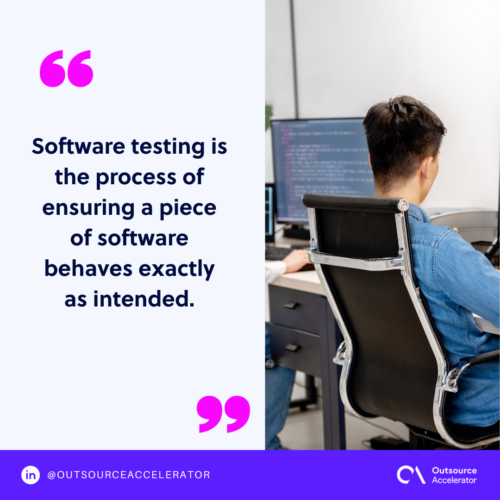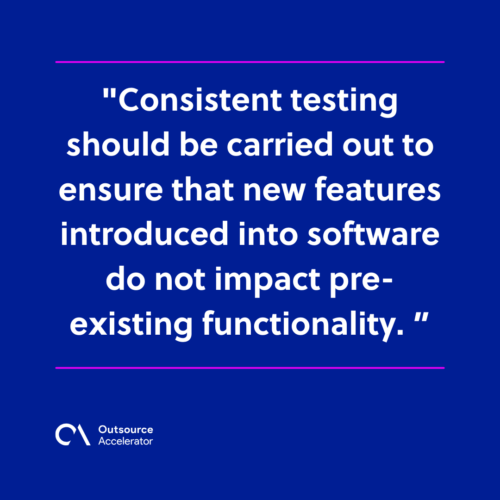What is software testing?

As the software development industry continues to grow at a rapid pace, the importance of software testing has become increasingly critical.
Technology is advancing more quickly than ever, and quality assurance (QA) ensures our digital tools work correctly before it’s released to the public.
Global Market Insights predicts the software testing market’s value will grow at a 5% CAGR between 2023 and 2032. This means it will be worth around US $90 billion worldwide in the coming years.
Let’s dive into the world of software testing. This article will define what it is and highlight its importance. We’ll also explore its types, uncover the software testing life cycle, and embrace best practices for efficient testing.
Software testing defined
Software testing is the process of ensuring a piece of software behaves exactly as intended.
It’s the gatekeeper that shields your digital creations from defects, bugs, and errors before they venture into the hands of the public.
Think of it as the quality control department striving to make your software reliable, efficient, and user-friendly.

Types of software testing
Different forms of software testing cater to distinct needs and objectives. Let’s explore some of the most common types:
- Acceptance testing. This involves testing the software in a production-like environment with real-world scenarios. It ensures that the software meets specified requirements and is ready for delivery.
- User acceptance testing (UAT). End-users or clients perform UAT to validate that the software meets their expectations and requirements.
- Integration testing. This verifies if different components or modules of the software function together correctly.
- Unit testing. Unit testing involves testing individual components or units of the software to verify that they work as expected. It aims to identify and rectify any defects at the earliest stage of development.
- Functional testing. This type of testing focuses on evaluating the software’s functionalities against specified requirements.
- Usability testing. This evaluates the software’s user-friendliness and ease of use. Usability testing assesses how users interact with the software and identifies potential use issues.
- Performance testing. Performance testing assesses how the software performs under specific workloads and conditions. It checks for responsiveness, scalability, and stability under different strain levels.
- Regression testing. This ensures that recent changes or enhancements to the software have not introduced any new defects or broken any existing functionality.
- Stress testing. Stress testing evaluates the software’s stability and performance under extreme conditions or heavy workloads. It checks for the ability to handle high traffic or the maximum capacity software can endure.
- Smoke testing. This is also referred to as confidence testing or build verification testing. Smoke testing preliminary checks to see if critical functions work as expected after each build or release.
- System testing. System testing ensures the entire system, including all interconnected components, works seamlessly together.
- Security testing. This identifies software vulnerabilities and weaknesses that hackers or malicious users could exploit. It ensures there are robust security measures to protect sensitive data.
Software testing life cycle
The software testing life cycle (STLC) is your roadmap to efficient and effective testing.
Entry and exit criteria are essential elements of the STLC. Entry criteria define the conditions that must be met before testing can begin, while exit criteria are the conditions that must be fulfilled for testing to be considered complete.

The STLC process is similar to the software development life cycle (SDLC) process. It includes six steps:
1. Requirement analysis. This step involves a detailed analysis of software requirements to develop an effective testing plan.
2. Test planning. Having a test strategy is essential in determining the extent, areas, and testing methods to be performed.
3. Test case development. This includes the development of test cases, test scripts, and the environment where testing will occur.
4. Test environment setup. It involves setting up the test environment with appropriate hardware, software, and network configurations to replicate the production environment for testing.
5. Test execution. This is the process of running tests, evaluating their results, and recording the outcomes.
6. Test cycle closure. This stage analyzes test results, assesses software against predefined acceptance criteria, reports defects, and creates a test closure report.
Importance of software testing
Software testing is vital in the development process for many reasons, including:
Bug detection
Testing serves as the first line of defense against those pesky bugs and errors that can cripple your software.
Nipping these issues in the bud during development is far more cost-effective than dealing with them after your software is out in the wild.
User satisfaction
Effective testing ensures that your software performs as expected, providing a seamless user experience. Satisfied users are not only more likely to keep using your software but also to sing its praises to others.
Security assurance
In an era of increasing cyber threats, software testing is essential for identifying vulnerabilities and ensuring that sensitive data remains secure.
Medium highlights software testing as a significant factor in maintaining security. A thoroughly-checked software can withstand attacks throughout time and remain stable.
Compliance and regulations
For businesses in regulated industries, testing is the compass that ensures you sail within the legal boundaries. Compliance is not just a checkbox — it’s a lifeline that can save you from costly penalties and legal entanglements.
Cost savings
Testing software early in the development process is like an investment that pays dividends. It saves you precious time, money, and resources that would otherwise be squandered on post-release firefighting.
Software testing best practices
Here are some effective strategies when conducting software QA:
Conduct testing early
Testing should be carried out as early in the software development cycle as possible. This helps detect issues before the code reaches too advanced of a stage and prevents unnecessary rework.
Use automation tools
Use test automation tools to speed up repetitive and time-consuming testing tasks.
RWS revealed that 44% of IT organizations automated their testing pre-pandemic. Companies that embraced automation in QA processes cut substantial costs and time and freed up valuable human resources.
Ensure test coverage
Test coverage ensures that all possible scenarios are accounted for during testing. It’s important to thoroughly document test cases, results, and defects to provide clear information to developers.
Constant communication
Communication is critical between the testing team and the development team. Constant communication ensures that critical bugs are identified and resolved in real-time.
Consistent testing
Consistent testing should be carried out to ensure that new features introduced into software do not impact pre-existing functionality.
Ensure test data accurately reflects real-world scenarios to identify issues that users may encounter.

Practicing efficient software testing
Efficiency is the name of the game. Follow a well-defined STLC and employ various testing types to ensure your software meets high standards and user expectations.
Moreover, outsourcing software testing to specialized providers can be a viable option.
As per Magnitia, 38% of companies outsource their software QA to tap into specialized expertise, reduce costs, and focus on core business activities.
You can test in-house or partner with an outsourcing firm like Arcanys which specializes in software development. Either way, efficient software testing is your ticket to delivering top-notch digital products.







 Independent
Independent




